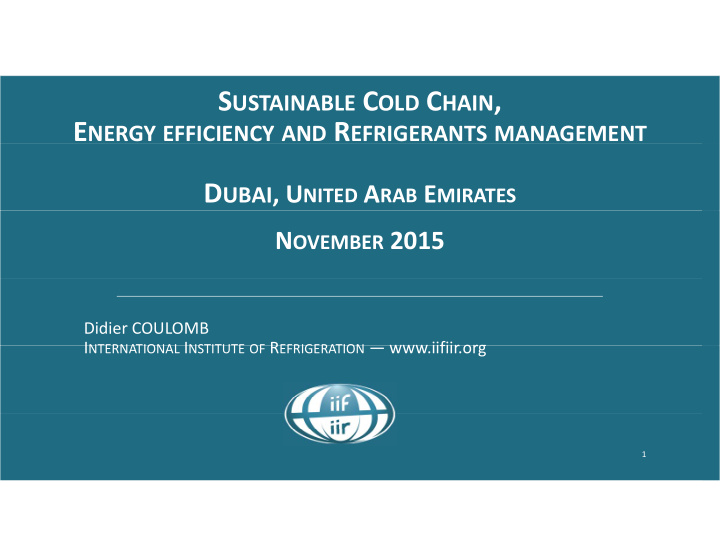



S USTAINABLE C OLD C HAIN , E NERGY EFFICIENCY AND R EFRIGERANTS MANAGEMENT D UBAI , U NITED A RAB E MIRATES N OVEMBER 2015 Didier COULOMB I NTERNATIONAL I NSTITUTE OF R EFRIGERATION I NTERNATIONAL I NSTITUTE OF R EFRIGERATION ― www.iifiir.org www iifiir org www.iifiir.org 1
PLAN PLAN 1) Increasing needs of refrigeration 2) The energy issue ) 3) The refrigerants issue 4) IIR actions and partnerships www.iifiir.org 2
• Cryogenics (petrochemical refining, steel Refrigeration is industry, space industry, nuclear fusion…) everywhere everywhere • Medicine and health products (cryosurgery, anaesthesia, scanners, vaccines…) • Air conditioning (buildings, data centres…) • Food industry and the cold chain • Energy sector (including heat pumps, LNG, hydrogen ) hydrogen…) • Environment (including carbon capture and storage), public works, leisure activities… www.iifiir.org 3
1/ Increasing needs 1/ Increasing needs • 1,600 US deaths per year are due to pathogens, at in developing and least partly associated with poor temperature control with many more in “developing” countries. emerging countries emerging countries According to a WHO report (2008) refrigeration and g p ( ) g improved hygiene have reduced stomach cancer by 89% in men and 92% in women since 1930 in the USA. A growth in global population, particularly in Africa A growth in global population, particularly in Africa • and South Asia (9 ‐ 10 billion in 2050, about 8 billion in developing countries). • 70% (50% now) will be in urban areas (doubling in developing countries) increasing the need for cold developing countries), increasing the need for cold chains due to longer distances between production sites and markets and progressively more westernized Farmers in Kyrgyzstan. Credit: UNPEI models (meat...) www.iifiir.org 4
Increasing needs • 800 000 people are undernourished 800 000 l d i h d in developing and 23% of food losses are caused by a • emerging lack of refrigeration (vs 9% in developed countries) excluding developed countries) excluding countries consumers losses • If equivalent losses as in developed countries food supply + 15% / need in countries, food supply + 15% / need in 2050 = +70% • Food losses means wastes of water, soils and energy soils and energy • Refrigerated capacity storage: 10 fold in developed countries Farmers in Kyrgyzstan. Credit: UNPEI (figures IIR and FAO) (figures IIR and FAO) www.iifiir.org 5
Comparison of available cold storage capacity per inhabitant in Comparison of available cold storage capacity per inhabitant in some sub ‐ Saharan African countries Countries Ethiopia United Namibia South Africa Republic of p Tanzania Capacity (litres 2 2 5,1 15 /inhabitant in urban area) urban area) Sources : IARW, 2012 Nota Nota: data for 2012, except for South Africa, where the capacity is indicated for 2008 www.iifiir.org 6
A recent MIT study showed mortality during hot days (temperatures higher than 32°C) decreased by 80% between 1900 ‐ 1959 and 1960 ‐ 2004 in the US: « The adoption of residential air ‐ conditioning explains i th US Th d ti f id ti l i diti i l i essentially the entire decline in the temperature ‐ mortality relationship » The IPCC forecasts an increase in air conditioning of 75% until 2100 The IPCC forecasts an increase in air conditioning of 75% until 2100 www.iifiir.org 7
Increasing needs especially in emerging and developing countries means increase in developing countries means increase in environmental impact www.iifiir.org 8
2/ the energy issue : 2/ the energy issue : Energy consumption in refrigeration equipment, including air conditioning equipment must be reduced conditioning equipment, must be reduced. Latest estimation*: 17% of worldwide electricity consumption (even more in Middle East countries due to air ‐ conditioning use), lack of energy resources, and indirect global warming impact (the most energy resources and indirect global warming impact (the most important one). � use of renewables, insulation, better energy efficiency …. (*) IIR Informatory Note to be published ( ) y p www.iifiir.org 9
www.iifiir.org 10
www.iifiir.org 11
www.iifiir.org 12
3/ The refrigerants issue 3/ The refrigerants issue • Phase out of HCFCs • Restrictions concerning HFCs � New policy to be implemented, taking into account increasing needs of p y p , g g refrigeration + energy consumption www.iifiir.org 13
4/ IIR actions and partnerships 4/ IIR actions and partnerships • in developed countries ‒ European research projects: FRISBEE, Cool Save, REAL Alternatives Documents available via the IIR website WWW.iifiir.org, free of charge h ‒ IIR scientific and technical conferences: the next IIR conference Sustainability and the Cold Chain in New Zealand (April 7 ‐ 9, 2016) ‒ Fridoc database www.iifiir.org 14
IIR actions and partnerships • in developing countries ‒ Partnerships with FAO and UNIDO � IIR/FAO policy brief, IIR guide p / p y , g on cold storage (underway) FAO project Meeting Urban Food Needs with IIR participation (underway) ( y) ‒ Partnership with CIHEAM � publications (latest one: CIHEAM Watchletter September 2015) ‒ Partnership with UNEP � currently, organization of a seminar in Partnership with UNEP � currently organization of a seminar in Tunisia in March 2016 with the IIR Working group on the Cold Chain in Warm Countries www.iifiir.org … 15
Recommend
More recommend